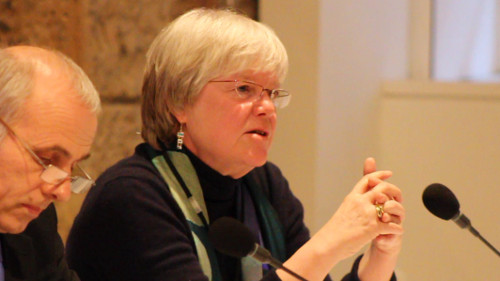
I’m intrigued and fascinated by everything that has gone before today – what particularly fascinates me about the whole range of discussion we’ve had today is the juxtaposition of the old and the new. We’ve heard little bits of history, and we’ve heard little bits about current practice in the creative industries. Now, many of the big question marks everyone has on their minds have to do with creators and their publics. And sometimes those creators and their publics are on the side of information exchange partnerships, and sometimes those creators and their publics are on the side of the economics of information and content sharing in not-yet-dead, but still very much alive, older paradigms. We keep talking about how you can the match scarcity of information to generate profits and in another sphere we have the abundance of the creative outputs of this industry.
We also have people talking a little bit about the top-down model, a mass market for new technologies and what we can do with them and all of the creative possibilities that go with that. And on the up side, we have people talking about generative models and innovation the industry itself has never thought of, and the things that creative individuals come along and get to do without really any knowledge of the law etc. And it’s that space in between that seems to be exactly, if I’ve heard you correctly, where the CREATe programme is, and that’s why it will be great to see the outputs from the whole programme.
The point I’d like to emphasise when it comes to at least my experience of interdisciplinary areas for quite a long time, is essentially a methodological one. I don’t want to become boring about this, but I want to talk about the actual practice of coming together and generating a research programme and an evidence base. Now it could be quite simple to suggest we will generate a new, novel, interdisciplinary evidence base, but the actual practice of generating that evidence base, in this space in between old models and new models, is itself conflicted, in the sense that, if you’ve ever tried to collaborate across academia and industry, with some of the large data traces that are being left, trying to get access to them, you very soon find, you have to negotiate new agreements about whether you, as an academic, can publish, when you can publish, whether you should sign confidentiality agreements, what might those repercussions be to even tell your colleagues sitting next door to you, whether or not you have access to that data. Sometimes, that can be a very productive relationship, because we are trying to learn, we are trying to know, but the question in interdisciplinary terms is that when different disciplines, the law, economists, sociologists, social studies people, political scientists come together, with their different notions of independent, interdisciplinary research, that too, I think, is a space that really deserves exploration in a programme like this. I imagine those surprising complexes will come to light.
My hope is, through a long-term programme, that you and your results will be able to teach others, how better to negotiate these very difficult relationships between private, commercially sensitive data. And particularly privacy as well, in terms of commercially sensitive data, how do we deal with that increasingly strong line between big commercially sensitive data that could tell us a huge amount of things about the dynamics going on in that space in between. And the notion of public domain research – I think, methodologically, that probably is something that you hold already in the work packages, even though nobody wants to talk about method.
 Resource
Resource